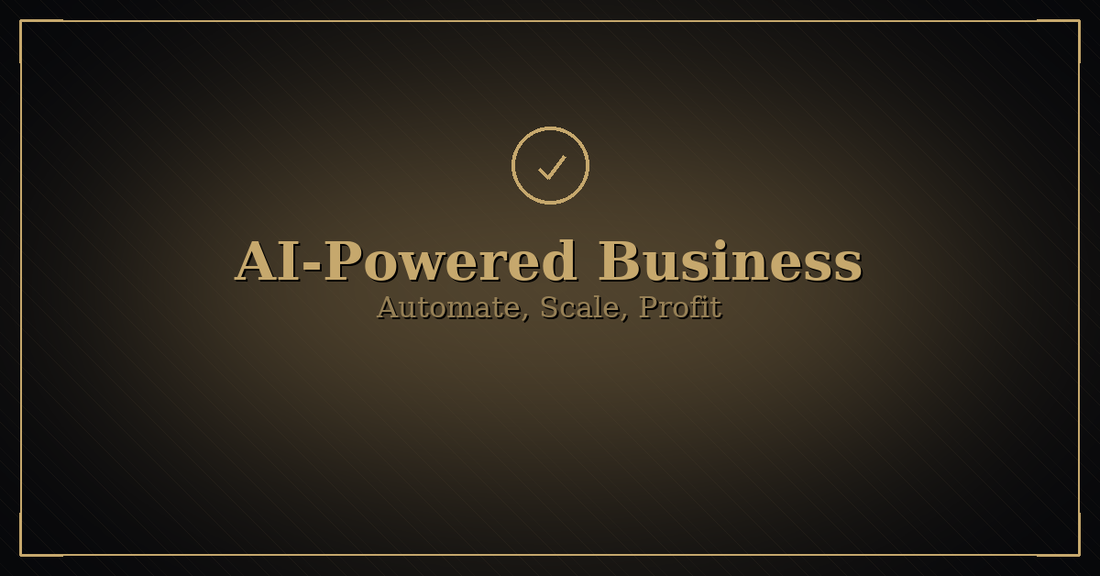
AI-Powered Business: Automate, Scale, Profit
Share
The Reality Check
Most teams add AI like a shiny attachment and wonder why nothing moves. The blunt truth:
If the process is vague, automating it multiplies chaos.
If nobody owns the result, prompts won’t save you.
If you don’t measure lift, you’re doing tech theatre.
Your aim is throughput with quality: more qualified attention, faster responses, tighter handoffs, fewer errors—without burning headcount.
The Three Levers: Automate, Augment, Accelerate
Automate: Remove manual, rule-based steps (routing, formatting, tagging, summaries, first drafts, status updates).
Augment: Keep a human in the loop to review, edit, decide—AI handles 70–90% of the grunt work.
Accelerate: Use AI to explore more options faster (variant testing, research synthesis, messaging angles, outlines) so winners surface quickly.
Every workflow you build should say which lever it pulls—and how you’ll measure lift.
Quick Start: The 90-Minute AI Audit
List your weekly tasks (personal + team). Timebox to 15 minutes.
Bucket them: Lead Gen, Sales, Support, Content, Ops/Finance, Analytics.
Score each task on: Repetition (R), Rules (Ru), Risk (Ri), ROI (Ro).
Prioritize high R + Ru, low Ri, high Ro.
Pick three workflows to tackle this month. Name an owner for each.
Define success metrics before you touch a single tool.
Five High-Impact Workflows (With Steps & Metrics)
1) AI-Assisted Lead Generation Engine
Goal: More qualified leads per week with less manual effort.
Inputs: ICP profile, offers, past top-performing messages.
Build:
Use AI to research micro-segments and extract pain-language from public sources and your own CRM notes.
Generate 5–10 outreach angles; create short, plain-English variants (no fluff).
Auto-enrich leads (industry, size, role) and tag by intent signals.
Push variants into your outreach tool; set rules for follow-ups (timing, objection type).
Human reviews first 20 sends to calibrate tone; then scale.
Measure: Reply rate (positive only), booked calls per 100 messages, cost per qualified lead, unsubscribe/complaint rate.
2) Content-to-Demand System (From Ideas to Leads)
Goal: Turn content into pipeline, not just views.
Inputs: Core topics tied to offers, FAQs from sales/support.
Build:
Turn FAQs into outlines, then into concise posts, then into longer explainers.
Generate title/meta/intro variants; keep the winner that matches search intent (informational vs. transactional).
Add a relevant CTA every time: checklist, template, or “book a 15-min call.”
Repurpose: blog → email snippet → social thread → short video script.
Schedule weekly; automate internal links to your key service/product pages.
Measure: Organic clicks to offer pages, email signups per post, time on page, assisted conversions.
3) Sales Follow-Up Copilot
Goal: Faster, smarter follow-ups that respect context.
Inputs: Call notes, key objections, pricing and packages, case proofs.
Build:
Auto-summarize calls into 5 bullets with next steps.
Generate follow-up drafts tailored to objection type (price, timing, authority).
Auto-insert relevant proof (short case, testimonial line).
Human edits in <90 seconds; send.
Schedule nudges: Day 2, Day 5, Day 12, then a polite close-the-loop.
Measure: Time to follow-up, stage-to-stage conversion, win rate, reasons lost.
4) AI-First Customer Support (Quality + Speed)
Goal: Resolve faster without sounding robotic.
Inputs: Knowledge base, policy rules, tone guide.
Build:
AI suggests answers based on your KB; agent approves/edits.
Auto-tag tickets (topic, product, sentiment) for routing and analytics.
Detect “churn risk” phrases; escalate to a human with a save-offer template.
Convert solved tickets into KB updates and public FAQs.
Measure: First response time, resolution time, deflection rate (self-serve), CSAT, churn among ticket-openers.
5) Back-Office Ops: Finance & Reporting
Goal: Cleaner books, fewer errors, faster decisions.
Inputs: Invoices, payouts, expenses, product catalog, pricing rules.
Build:
Auto-extract invoice data; flag anomalies (amounts, vendor, dates).
Create weekly cash view and 13-week simple forecast (receivables, payables, recurring costs).
Auto-assemble ops report: leads, pipeline, sales, churn, gross margin, cash runway—one page, no jargon.
Send to leadership every Monday 9:00.
Measure: Close-the-books time, error rate, “time to decision,” variance vs. forecast.
Guardrails: Keep Your Wins, Avoid the Pitfalls
Privacy & access: Keep sensitive data in least-privilege silos. Redact customer PII in prompts whenever possible.
Human oversight: Anything legal, financial, or reputational gets a human review.
Truth vs. fluency: A confident answer can still be wrong. For facts, ask AI to cite sources you can verify.
Process first: Fix the workflow on paper before you automate. Bad process × AI = faster failure.
Versioning: Save winning prompts and templates; change one variable at a time; log results.
Metrics That Actually Matter (Ditch Vanity)
Acquisition: Cost per qualified lead (CPQL), positive reply rate, booked calls.
Conversion: Stage conversion by cohort, sales cycle days, win rate by segment.
Retention/Expansion: Activation rate, repeat purchase, churn, net revenue retention.
Efficiency: Cycle time (idea → ship), tickets resolved/agent, hours saved/role.
Cash: Gross margin, burn, runway, variance vs. plan.
Pick three that tie directly to this quarter’s goal. Review weekly.
The 0-30-60-90 Roadmap (Simple & Realistic)
Days 0–30: Prove Lift on One Workflow
Choose one: Lead Gen Engine or Sales Follow-Up Copilot.
Define “success” (e.g., +30% positive replies or −50% time to follow-up).
Build a minimal version; run for two full cycles.
Keep a human editor. Save the winning prompts/templates.
Days 31–60: Add a Second Workflow + Reporting
Layer in Support or Content-to-Demand.
Stand up a simple weekly ops report.
Document SOPs: inputs, steps, owner, metrics.
Days 61–90: Scale, Standardize, Safeguard
Roll to more team members.
Add guardrails (PII redaction, approval rules).
Set quarterly targets; lock a cadence: build → measure → refine.
Roles You Need (Even in a Small Team)
Builder: Assembles workflows, connects tools, drafts prompts.
Editor: Reviews outputs for accuracy, tone, and compliance.
Operator: Watches dashboards, fixes bottlenecks, keeps SOPs current.
One person can wear two hats; don’t skip the editor.
Plain-English Prompt Patterns That Work
Instruction first: “You are an editor for concise B2B emails. Rewrite the message to be 120–150 words, plain English, with one clear CTA.”
Context and constraints: “Audience: Head of Operations in e-commerce, 50–200 employees. Avoid jargon. Include one proof point.”
Quality bar: “Return 2 variants. End with a question that invites a yes/no reply.”
Verification: “List any facts you asserted and what source you relied on.”
Save and reuse. Prompts are SOPs.
SEO Without the Magic Thinking
Search intent first: Don’t write “ultimate guides” for transactional keywords. Match format to intent (comparisons, checklists, FAQs).
Topic clusters: One pillar page + 6–10 specific sub-posts. Interlink both ways with descriptive anchors.
Useful intros: State the outcome in the first 3 sentences. People and crawlers both reward clarity.
Consistent CTAs: Offer a next step that fits the page (template, audit checklist, 15-min call).
Maintenance: Update winners quarterly—improve examples, tighten intros, add FAQs from support/sales.
Weekly AI-Ops Routine (30 Minutes, Calendar It)
Monday: Review last week’s metrics, choose one bottleneck, assign one fix.
Wednesday: Ship a small improvement (faster handoff, better template, clearer CTA).
Friday: Log what worked, archive what didn’t, update SOPs, pick next experiment.
Small, relentless steps beat sporadic “big pushes.”
FAQs (For Humans and Featured Snippets)
Do I need a developer to start?
No. Start with off-the-shelf tools and clear SOPs. Add engineering later for speed, scale, or security.
How much budget does this take?
Begin with a pilot that pays for itself in 30–45 days: one workflow, one metric lift. If it doesn’t move, stop and rethink.
Will AI replace my team?
It will replace parts of tasks. Keep humans as editors and decision-makers; let AI handle repetition and drafts.
What’s the first workflow to automate?
Pick the one with high repetition, clear rules, and low risk—commonly: sales follow-ups or support replies.
Your Next 30 Minutes (Do This Now)
Write your top three outcomes for this quarter.
Choose one workflow that directly moves one outcome.
Define success and a single metric.
Build the smallest version and run it for two cycles.
Keep a human editor. Measure. Improve. Repeat.
Results depend on your execution, market, and consistency. No guarantees—just a clear path that works when you do.
If you want to go deeper into this playbook and get a structured roadmap you can apply right away, check out AI-Powered Business: Automate, Scale & Profit in our shop at vipresspublishing.com. The eBook gives you practical frameworks, workflows, and case-driven examples to build systems that actually scale.
